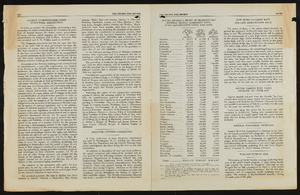Search the Special Collections and Archives Portal
Search Results

Transcript of interview with Gus Mancuso by Lisa Gioia-Acres, September 27, 2008
Date
Archival Collection
Description
Text

Transcript of interview with Renee Diamond by Barbara Tabach, November 20, 2014
Date
Archival Collection
Description
In this interview, Renee Diamond discusses coming to Las Vegas via Los Angeles, with her husband and children in the 1970s and getting involved in politics. She talks about her husband, Leo, and his business selling vinyl records in L.A., and her work in a doctor's office. Once in Las Vegas, the Diamonds joined Temple Beth Sholom and later Congregation Ner Tamid. Renee talks about her involvement in the political arena in southern Nevada, including the League of Women Voters.
Community activism and social justice rank high in the legacy of Renee Diamond. She often refers to herself as one of the last of the generation without college degrees that could make a difference in the politics of the state. When Renee, her husband Leo Diamond moved their family to Las Vegas from southern California, the energetic advocate Renee quickly plugged into the community. The word "No" was not part of her vocabulary. Among the many Jewish and secular activities the she engaged in were: the editorial board of the Jewish Reporter newspaper; Hadassah; Anti-Defamation League; Red Cross Board; State Museum Board to name a few. She remains a vibrant Democratic Party leader and served one term on the Nevada Assembly in 1989. She was on the front lines as a fierce and active supporter of Welfare Rights, Fair Housing and the Equal Rights Amendment. It is a life that included working alongside illustrious women and men of Southern Nevada history. A list that includes: Harriet Trudell, Ruby Duncan, Myrna Williams and Dorothy Eisenberg and many more mentioned here. Meanwhile she raised four children and enjoyed a loving 43-year marriage with Leo (aka "Uncle Leo") whose career included the popular Bingo Palace, Slots-A-Fun and Stations Casinos. During this oral history interview she recalls the Las Vegas that she moved to in 1972 and reflects on what attracted people here, ways to be part of the Jewish life which might even include a bowling league and how involvement in raising social awareness was a worthy investment of ones' time. This is a look at a woman who made a difference.
Text

Interview with Leslie Ray Hill, February 17, 2006
Date
Archival Collection
Description
Text
Denton, Hazel Baker, 1887-1962
Hazel Baker Denton (1887-1962) was a prolific writer, educator, active community member, and elected to serve the Nevada State Assembly in the early 1950s.
Person
Cohen, Burton M., 1923-2014
Burton Cohen (1923-2014) was a casino executive in Las Vegas, Nevada who held management positions at iconic Strip properties such as the Frontier, Desert Inn, Flamingo, Caesars Palace, Thunderbird, and Dunes. Cohen grew up in Miami, Florida where he graduated from the University of Florida. During World War II he served in the Army Air Corps and trained as a pilot. After returning to the United States he enrolled at the University of Miami and earned a law degree in 1948.
Person
Pat Jones Photograph Collection
Identifier
Abstract
The Pat Jones Photograph Collection (approximately 1925-1930) consists of black-and-white photographic prints and slides of Harry Suiter in Rhyolite, Nevada. There are images of Suiter standing in front of abandoned buildings, as well as scenery near Rhyolite. Also included is an image of a wagon transport containing borax in Death Valley, California.
Archival Collection
First Methodist Church of Las Vegas Photograph Collection
Identifier
Abstract
The First Methodist Church Photograph Collection (approximately 1909-1912) contains black-and-white photographic prints and corresponding negatives of the Las Vegas train depot, railroad yards, and the First Methodist Church in Las Vegas, Nevada. Also included are portraits of Reverend Edwin A. Palmer and his family.
Archival Collection
Edward Joseph Deck Photograph Collection
Identifier
Abstract
The Edward Joseph Deck Photograph Collection (approximately 1870-1920) consists of photographic prints and negatives of Edward Joseph Deck and other miners in Pioche, Nevada and various locations around the townsite. There are also images of ranches, mills, and mill workers both in and outside of the Pioche townsite.
Archival Collection
Nino Maurizi Photograph Collection
Identifier
Abstract
The Nino Maurizi Photograph Collection consists of two black-and-white photographic prints and corresponding negatives of Nino Maurizi at the Mount Charleston Camp for the Las Vegas Army Air Field in 1943. Images depict Maurizi standing at the entrance of Mount Charleston Camp as well as inside the camp.
Archival Collection

